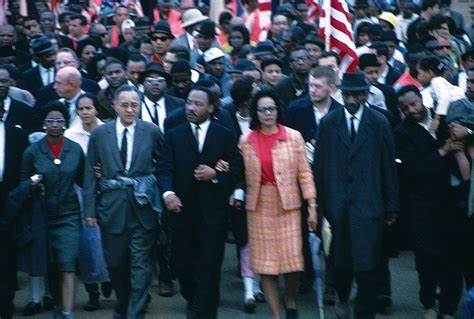When the U.S. Congress passed civil rights legislation 60 years ago on July 2, then-President Lyndon Johnson signed it into law within hours.
The Civil Rights Act of 1964 was the culmination of a decades-long movement, led by Martin Luther King Jr., to achieve equality for African Americans. The act makes discrimination based on race, colour, religion, sex or national origin illegal.
The achievement, long-fought for, would be followed by the Voting Rights Act of 1965, which outlaws many discriminatory voting practices, and the Fair Housing Act of 1968, which bars discrimination in the housing industry. Pressure brought by civil-rights activists in the South, including Martin Luther King Jr., who led marches and boycotts, brought the issue to the attention of millions of Americans.
King’s letter from the Birmingham jail, the police dogs attacking peaceful protesters in Birmingham, the March on Washington: all these things made Americans — and their leaders — feel like something had to be done. The Civil Rights Act ended many of the government-sanctioned injustices that had persisted for generations in the South.
With relative speed, we saw the end of so-called “white” soda fountains, lunch counters, bowling alleys, amusement parks, restaurants, hotels and more. The act was not as effective in fighting segregation in schools, housing and hiring.
Still, it sent an important message and inspired more successful protest movements. It’s important today because it shows the government’s power to change behaviour, expand opportunity, guarantee equal rights and make redress for past discrimination. The Civil Rights Act of 1964 made segregation in public accommodations (in institutions above a certain size) illegal and liable to lawsuits in federal court by the U.S. Department of Justice.
The law also outlawed racial and gender discrimination in employment by businesses of a certain size and authorized a new federal agency, the Equal Employment Opportunity Commission, to investigate and enforce the law. The Voting Rights Act of 1965 authorized direct federal intervention to protect voting rights in states that could be shown to have a historical pattern of denying Black citizens’ voting rights.
During the 1970s and ‘80s, there were dramatic increases in the size of the Black middle class and the number of Black officeholders at every level — all of which was a direct result of these legal changes. Consider three people at the very centre of the movement for civil rights, W.E.B. DuBois (1868–1963), A. Philip Randolph (1889–1979) and Septima Clark (1898–1987).
It is fair to say that the modern Civil Rights Movement would have been very different, and less successful, without these three giants, and they are not alone among significant elders. At the same time, there was a significant presence of young people in the movement .
After all, King was just 26 when the Montgomery bus boycott began. But there were many members of the Silent Generation (born 1928–1945) who played a catalytic role in the movement through 1965: Diane Nash, Robert Moses, David Dennis, John Lewis, Connie Curry, Gloria Richardson, Ruby Doris Smith, Hollis Watkins, Chuck McDew, Stokely Carmichael (Kwame Ture) and many hundreds more. Understand, the passages of the Civil Rights Act and the Voting Rights Act resulted from a multigenerational movement, a movement of people in their teens, 20s, 30s, 40s, 50s, 60s and 70s.
The Civil Rights Act created opportunity for people to create relationships across race and religion and different cultures. It opened up a way for non-white people to live a life of freedom and prosperity. It began the process of people accepting equal status of Black citizens.
Before then, people were totally seen and thought of as inferior. Today, how do you correct past injustices in a way that doesn’t run roughshod over another community?
And if you revert to discriminating against citizens, what does that mean? Those are the conversations needed to engage in, so that you have credibility to challenge other nations on their policies and practices.


















